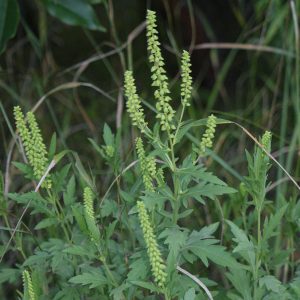[OK … so this isn’t strictly IPM. But it does shed light on a glorious native plant that gets a bad rap for making the allergy-prone among us miserable — and its weedy relative, found in city and country alike, that’s to blame. An IPM solution? Prevention, for one — education about weeding weedy city lots before ragweed flowers.]
It’s late summer and we are awash in brilliant oceans of mustard-yellow goldenrod blooms. At the same time, hay fever symptoms are ramping up.
As goldenrod becomes the dominant wildflower on the scene, an increased pollen load in the air is making life miserable for those who suffer from allergies. Because of this correlation, it seems logical to blame goldenrod for your red itchy eyes, sinus congestion, sneezing, and general histamine-soaked misery.

But there is an easy way to tell for sure if goldenrod is to blame — a one-question test: Have you noticed a lot of bees up your nose recently? If yes, then goldenrod might be guilty. If no, there is another culprit lurking about.
As one of the most abundant blooms of late summer and early autumn, this native wildflower is for many insects, including numerous bee species, a vital source of nectar as well as nutritious pollen.
Unfortunately, this latter item has given goldenrod a black eye among many allergy sufferers.
But consider this — goldenrod isn’t common in vacant city lots. And lots of hay fever suffers live in cities. Besides, goldenrod can’t be guilty because its pollen is very heavy. That’s a relative term, I suppose, since it is light enough for bees to carry it around. Yet in the pollen realm it’s heavy—and is also very sticky—and can’t be blown far from the plant.
For goldenrod pollen to trigger an allergic response, someone or something would have to deposit its pollen directly into your schnozz. And in general, bees are not in the habit of doing so.

So who’s to blame for the spike in late summer allergies? Surprisingly, the culprit is goldenrod’s cousin, ragweed, although it doesn’t behave at all like its golden relative. Ragweed, another native plant, is also in the aster family, but unlike goldenrod it churns out loads of very light pollen.
Just how light? Ragweed pollen can remain airborne for several days, and significant quantities have been found as far as 400 miles out to sea. Ragweed easily colonizes vacant city lots, where a single ragweed plant can produce a billion pollen grains to fly on the breeze and make you sneeze.
Yep, this is the stuff that stuffs you up.
One reason we don’t suspect ragweed is that its blossoms are dull green and look nothing like a typical flower. It’s as if they’re trying not to attract attention. Because it’s wind-pollinated, it has no need to advertise with bright colors and sweet nectar to entice pollinators.
Turns out it’s way easier to attract wind than bees.
Most ragweed species—there are about 50 of them—are annual, but they come back year after year from the copious seeds they produce each fall. Ragweed will keep billowing allergens until the first hard frost, so let’s hope it’s not too much of an extended season this year. And let’s spread the word about goldenrod to spare it further false accusations.
[Our thanks to Paul Hetzler for his kind permission to use this story. Hetzler is a horticulture and natural resources educator with Cornell Cooperative Extension of St. Lawrence County. Unedited original at https://blogs.northcountrypublicradio.org/allin/2017/09/10/dont-blame-goldenrod-for-your-bless-you-hay-fever-symptoms/]